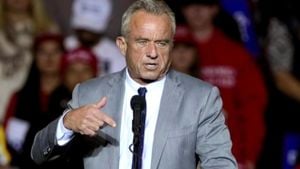Recent weeks have brought significant tensions to the surface in the Ukraine-Russia conflict, with major escalations threatening to engulf the region and, potentially, the entire world. The week leading up to November 23, 2024, was pivotal, characterized by policy shifts from the United States and reactions from the Kremlin. With Ukraine's military actions increasing and the use of advanced weaponry, the stakes have rarely been higher.
The crux of the matter began when President Joe Biden approved Ukraine's deployment of longer-range missiles, namely the Army Tactical Missile System (ATACMS), inside Russian territory. This policy reversal had been several months in the making, especially as NATO allies and the U.S. found themselves under pressure from Russia's growing reliance on North Korean troops. The deployment raised concerns about the potential for direct confrontation between Western forces and Russia.
From the onset, the Kremlin was quick to respond. Dmitry Peskov, spokesperson for Russian President Vladimir Putin, warned of escalations if Western weapons were used, indicating potential backlash against any countries backing Ukraine's military actions. Indeed, it seems the tension between the U.S. and Russia had reached boiling point, with Putin's government expressing alarm at the transfer of missile capabilities.
Things took another sharp turn when Ukraine successfully struck targets inside Russia for the first time using ATACMS missiles. Reports indicated these precise military operations targeted ammunition depots, raising the level of pressure on Russia, which had intensified its rhetoric following Ukraine's newfound capabilities.
Alongside these military developments, the Biden administration announced plans to provide Ukraine with anti-personnel mines, indicating another shift from their previous stance against such weapons due to humanitarian concerns. This move has sparked debates over the ethical ramifications of deploying land mines, which can remain dangerous long after conflicts have ended.
Russian forces, feeling cornered by these developments, unveiled their experimental hypersonic missile, the Oreshnik, which Putin claimed is nearly untouchable by existing defense systems. The new missile, capable of flying at speeds exceeding ten times the speed of sound, marked Russia's response to what it saw as provocations from Ukraine and its Western allies.
Putin’s announcement came with solemn warnings to the West, claiming his country had the capability to retaliate against any nation deemed supportive of Ukraine’s actions—a clear indication of the heightened risks of military engagements. Analysts have described the mood on the ground as rife with uncertainty and fear over the prospect of nuclear arms becoming part of the conflict strategy.
The week also witnessed NATO and Ukrainian leaders convening emergency meetings as they assessed the rapidly changing battlefield. Leaders, including Poland’s Prime Minister Donald Tusk, voiced concerns about the conflict's shift to more dangerous ground, emphasizing the dire need for unity and strategic responses to the conflict.
This week's turbulent events created echoing ripples across the globe, with not only military tactics being on full display, but also diplomatic challenges mounting among Western allies—many of whom have expressed cautious optimism for peace but are now faced with choices complicate the path to any potential resolution.
To add more fuel to this already raging fire, Russia’s ambassador to the UK, Andrey Kelin, posited inflammatory claims, asserting the involvement of NATO nations was moving them closer to direct conflict with Russia. His comments underscored the crippling belief among some Russian officials of Western nations’ involvement bringing them closer to the fallout of potential nuclear engagements.
Ukraine, on its part, expressed determination to push back against these threats. President Volodymyr Zelenskyy warned of the serious ramifications of Russia's provocative stance, promising Ukraine would not yield. His administration has publicly called upon the international community to recognize the impending threats posed by Russia's militarization.
With the backdrop of celebrations marking nearly three years since the invasion began, the future of Ukraine and the broader geopolitical stability remains precarious. Each country involved navigates through the fog of war, driven by both national interests and the realities on the ground. The actions taken – whether aggression, defensive strategies, or supports from allies – hold the risk of spiraling the situation toward something far more disastrous.
The developments this past week have brought the potential for escalated military actions ever closer. Whether these moments mark the beginning of more aggressive approaches from either side—or serve as cautionary tales remains to be seen, but what is evident is the groundwork for more confrontations continues to be laid.
Only time will tell how many will heed the calls for peace versus those opting for military advances and their attendant risks. The international community watches with bated breath, recognizing the fragile balance between resilience and retaliation shaping this multifaceted conflict.



